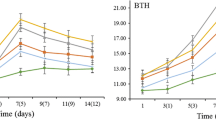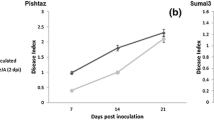Abstract
The oomycete Phytophthora melonis causes a severe disease in cucumber plants in Asia. In this study, the diameter of cucumber hypocotyl in the resistant variety ‘Shantou qing gua’ was significantly larger than that of the susceptible variety ‘Zhongnong No. 20’. The significantly lower incidence of disease and less invasive hyphae on the epidermis and transverse section of hypocotyls in P plants of the resistant variety than those in susceptible cultivars were also observed. Brassinosteroids are a class of phytohormones that affect plant growth and development and are involved in regulating plant resistance to a variety of biotic and abiotic stresses. 24-Epibrassinolide root drenching significantly enhanced the thickening of cucumber hypocotyl. Thick hypocotyls showed strong resistance to P. melonis, indicating that it significantly reduced the incidence of disease and retarded the hyphae extension for both resistant and susceptible cucumbers. 24-Epibrassinolide pretreatment had no significant effect on the elongation of cucumber hypocotyl. Further histological observation showed that under the condition of infection with P. melonis, exogenous 24-epibrassinolide could induce lignin deposition in external phloem and xylem vessel cell wall of the cucumber hypocotyl vascular bundle. There is also an accumulation of callose in the external phloem sieve plate, which activates the resistance responses in cell walls. It is worth mentioning that in both inoculated and uninoculated conditions, exogenous 24-epibrassinolide enhanced lignin formation in external phloem and xylem vessel cell wall of the vascular bundle. This increased the content of lignin in hypocotyl as well as the number of vascular bundles in the hypocotyl base. The above results show that 24-epibrassinolide constitutively regulates the thickening of cucumber hypocotyl and the development of vascular bundle, hence preventing phytophthora infection and inducing plant resistance to disease.






Similar content being viewed by others
References
Abkhoo J, Sabbagh SK (2016) Control of Phytophthora melonis damping-off, induction of defense responses, and gene expression of cucumber treated with commercial extract from Ascophyllum nodosum. J Appl Phycol 28:1333–1342. https://doi.org/10.1007/s10811-015-0693-3
Ali B (2017) Practical applications of brassinosteroids in horticulture—some field perspectives. Sci Hortic 225:15–21. https://doi.org/10.1016/j.scienta.2017.06.051
Ando K, Carr KM, Colle M, Mansfeld BN, Grumet R (2015) Exocarp properties and transcriptomic analysis of cucumber (Cucumis sativus) fruit expressing age-related resistance to Phytophthora capsici. PLoS One 10(11):e0142133. https://doi.org/10.1371/journal.pone.0142133
China Standard NY/T 1857.4 (2010) Rules for evaluation of cucumber for resistance to diseases. Part 4: Rule for evaluation of cucumber for resistance to phytophthora blight. Issued by Ministry of Agriculture of People’s Republic of China, Beijing
Clouse SD, Sasse JM (1998) Brassinosteroids: essential regulators of plant growth and development. Annu Rev Plant Physiol Plant Mol Biol 49:424–451. https://doi.org/10.1146/annurev.arplant.49.1.427
Ding J, Shi K, Zhou YH, Yu JQ (2009) Microbial community responses associated with the development of Fusarium oxysporum f. sp. cucumerinum after 24-epibrassinolide applications to shoots and roots in cucumber. Eur J Plant Pathol 124:141–150. https://doi.org/10.1007/s10658-008-9401-3
Granke LL, Hausbeck MK (2010) Effects of temperature, humidity, and wounding on development of phytophthora rot of cucumber fruit. Plant Dis 94(12):1417–1424. https://doi.org/10.1094/PDIS-04-10-0258
Haubrick LL, Assmann SM (2006) Brassinosteroids and plant function: some clues, more puzzles. Plant Cell Environ 29:446–457. https://doi.org/10.1111/j.1365-3040.2005.01481.x
Hückelhoven R (2007) Cell wall-associated mechanisms of disease resistance and susceptibility. Annu Rev Phytopathol 45:101–127. https://doi.org/10.1146/annurev.phyto.45.062806.094325
Ibañes M, Fàbregas N, Chory J, Caño-Delgado AI (2009) Brassinosteroid signaling and auxin transport are required to establish the periodic pattern of Arabidopsis shoot vascular bundles. PNAS. 106(32):13630–13635. https://doi.org/10.1073/pnas.0906416106
Kang SN, Yang F, Li L, Chen HM, Chen S, Zhang J (2015) The Arabidopsis transcription factor brassinosteroid insensitive 1-ethyl methanesulfonate-suppressor1 is a direct substrate of mitogen-activated protein kinase6 and regulates immunity. Plant Physiol 167:1076–1086. https://doi.org/10.1104/pp.114.250985
Luna E, Pastor V, Robert J, Flors V, Mauch-Mani B, Ton J (2011) Callose deposition: a multifaceted plant defense response. Mol Plant-Microbe Interact 24:183–193. https://doi.org/10.1094/MPMI-07-10-0149
Mansfeld BN, Colle M, Kang YY, Jones AD, Grumet R (2017) Transcriptomic and metabolomic analyses of cucumber fruit peels reveal a developmental increase in terpenoid glycosides associated with age-related resistance to Phytophthora capsici. Hortic Res 4:17022. https://doi.org/10.1038/hortres.2017.22
Marcos R, Izquierdo Y, Vellosillo T, Kulasekaran S, Cascón T, Hamberg M, Castresana C (2015) 9-Lipoxygenase-derived oxylipins activate brassinosteroid signaling to promote cell wall-based defense and limit pathogen infection. Plant Physiol 169(3):2324–2334. https://doi.org/10.1104/pp.15.00992
Nakashita H, Yasuda M, Nitta T, Asami T, Fujioka S, Arai Y, Sekimata K, Takatsuto S, Yamaguchi I, Yoshida S (2003) Brassinosteroid functions in a broad range of disease resistance in tobacco and rice. The Plant J 33:887–898. https://doi.org/10.1046/j.1365-313X.2003.01675.x
Piccinia C, Parrotta LG, Faleri C, Romi M, Del Duca S, Cai G (2019) Histomolecular responses in susceptible and resistant phenotypes of Capsicum annuum L. infected with Phytophthora capsici. Sci Hortic 244:122–133. https://doi.org/10.1016/j.scienta.2018.09.051
Roth U, Friebe A, Schnabl H (2000) Resistance induction in plants by a brassinosteroid-containing extract of Lychnis viscaria L. Zeitschrift Naturforschung C 55:552–559. https://doi.org/10.1515/znc-2000-7-813
Sunwoo JY, Lee KY, Hwang BK (1996) Induced resistance against Phytophthora capsici in pepper plants in response to DL-ß-amino-n-butyric acid. Eur J Plant Pathol 102:663–670. https://doi.org/10.1007/BF01877247
Tao K (2012) Molecular and cellular biology of interactions between Phytophthora sojae and host soybean [D] (in Chinese)
Vorwerk S, Somerville S, Somerville C (2004) The role of plant cell wall polysaccharide composition in disease resistance. Trends Plant Sci 9:203–209. https://doi.org/10.1016/j.tplants.2004.02.005
Wang Y, Bouwmeester K, Van De Mortel JE, Shan WX, Govers F (2013) A novel Arabidopsis-oomycete pathosystem: differential interactions with Phytophthora capsici reveal a role for camalexin, indole glucosinolates and salicylic acid in defence. Plant Cell and Environ 36:1192–1203. https://doi.org/10.1111/pce.12052
Wang H, Li WQ, Qin YG, Pan YP, Wang XF, Weng YQ, Chen P, Li YH (2017) The cytochrome p450 gene cscyp85a1 is a putative candidate for super compact-1 (scp-1) plant architecture mutation in cucumber (Cucumis sativus L.). Front Plant Sci. 8:266. https://doi.org/10.3389/fpls.2017.00266
Wu H, Hao G (2012) Botany experimental instruction [M]. China higher education press, Beijing
Wu YG, Lu SF, Huang SL, Fu G, Chen L, Xie DS, Li QQ, Cen ZL (2011) Field resistance of Phytophthora melonis to metalaxyl in South China. Acta Microbiol Sin 51(8):1078–1086 (in Chinese). https://doi.org/10.1016/S1671-2927(11)60313-1
Wu YG, Huang SL, Li WJ, Fu G, Hu CJ (2016) Identification and mating type determination of Phytophthora strains causing blight on two cucurbit crops in South China. Trop plant pathol 41(1):1–9. https://doi.org/10.1007/s40858-016-0066-8
Xia XJ, Zhou YH, Ding J, Shi K, Asami T, Chen Z, Yu JQ (2011) Induction of systemic stress tolerance by brassinosteroid in Cucumis sativus. New Phytol 191:706–720. https://doi.org/10.1111/j.1469-8137.2011.03745.x
Xu XM, Wang R, Chao J, Lin YE, Jin QM, He XM, Luo SB, Wu TQ (2015) The expression patterns of Cucumis sativus WRKY (CsWRKY) family under the condition of inoculation with Phytophthora melonis in disease resistant and susceptible cucumber cultivars. Can J Plant Sci 95:1121–1131. https://doi.org/10.4141/CJPS-2014-403
Yang H, Gou XP, He K, Xi DH, Du JB, Lin HH, Li J (2010) BAK1 and BKK1 in Arabidopsis thaliana confer reduced susceptibility to Turnip crinkle virus. Eur J Plant Pathol 127:149–156. https://doi.org/10.1007/s10658-010-9581-5
Zou LJ, Deng XG, Zhang LE, Zhu T, Tan WR, Muhammad A, Zhu LJ, Zhang C, Zhang DW, Lin HH (2018) Nitric oxide as a signaling molecule in brassinosteroid-mediated virus resistance to Cucumber mosaic virus in Arabidopsis thaliana. Physiol Plantarum 163(2):96–210. https://doi.org/10.1111/ppl.12677
Acknowledgments
This study was funded by the National Natural Science Foundation of China (31872090, 31301767), and the Guangdong Provincial Special Fund for Modern Agriculture Industry Technology Innovation Teams (No. 2019KJ122).
Author information
Authors and Affiliations
Contributions
All authors contributed to the study conception and design. Material preparation, data collection, and analysis were performed by Rongrong Ren, Aiting Song, Chenchen Li, HaijunYang, and Xian Yang. The first draft of the manuscript was written by Yunyan Kang, and all authors commented on previous versions of the manuscript. All authors read and approved the final manuscript.
Corresponding authors
Ethics declarations
Conflict of interest
The authors declare that they have no conflict of interest.
Additional information
Handling Editor: Ulrike Mathesius
Publisher’s note
Springer Nature remains neutral with regard to jurisdictional claims in published maps and institutional affiliations.
Electronic supplementary material
ESM 1
(DOCX 27 kb)
Rights and permissions
About this article
Cite this article
Ren, R., Yang, X., Song, A. et al. Control of Phytophthora melonis damping-off treated with 24-epibrassinolide and a histological study of cucumber hypocotyl. Protoplasma 257, 1519–1529 (2020). https://doi.org/10.1007/s00709-020-01523-y
Received:
Accepted:
Published:
Issue Date:
DOI: https://doi.org/10.1007/s00709-020-01523-y




